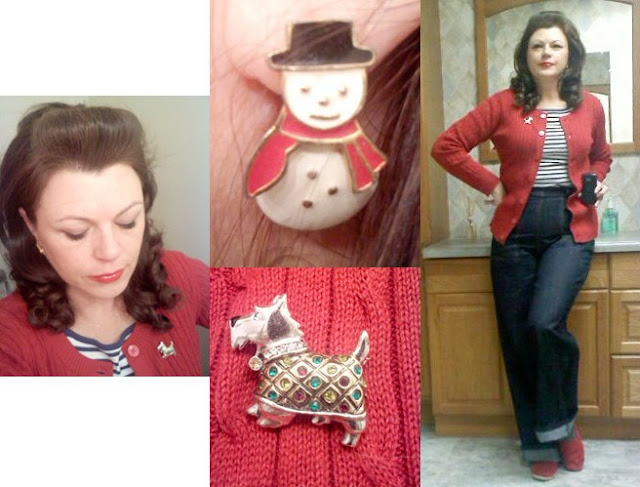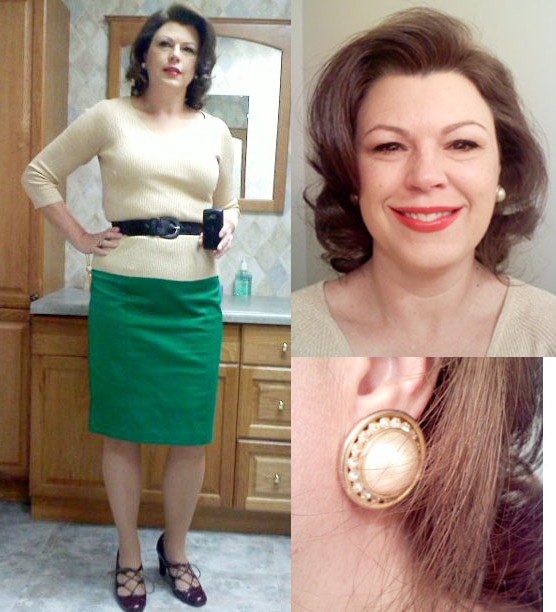 |
| Shirley's mother pin-curled her hair each night, always with 56 curls. |
When I was a little girl in the 60s and early 70s, my mom would always make a special dinner after church, usually some form of chicken because that was a treat for us to have, and after the meal was finished and the table cleared, we would all gather around the tv to watch an afternoon movie on one of the two channels that we could get. This is where I first saw Shirley Temple light up my tv screen. A darling dimpled, cherub faced girl with golden ringlets that bounced while she sang and danced and kept pace with a long list of grown up actors. She could do it all, and at the ripe old age of five!
 |
| 18 Months Old |
Shirley Jane Temple was born April 23, 1928 and at the age of three was discovered in a dance class and given a small acting job with Educational Pictures in a series of short films called "Baby Burlesks", in which they were all children between the ages of three and five and did spoofs of the adult movies at the time. Shirley played Marlene Dietrich and Mae West, among others.
 |
| A little femme fatale, 1933 |
 |
| Little Miss Marker, 1934 |
 |
| Morelegs Sweettrick, Kid in Hollywood, costume by her Mother, 1933. |
 |
| With Marlene Dietrich in 1934 |
After a few small roles in feature films, she was contracted to Fox where she made a startling debut in the 1934 musical, "Stand Up and Cheer", singing and dancing with James Dunn to the song - Baby, Take a Bow. Within the first week of the movie's release, Shirley had became the symbol of family wholesomeness. Her career took off like wildfire and her movies were credited with restoring the Fox Film studio to profitability when it had been teetering on the brink of bankruptcy. There were millions of dollars spent on merchandise with her likeness on it, such as dolls, records, mugs, hats, dresses. There's even a drink made in her honor.
 |
| Signing contract with her Father at Fox Studios in 1934 |
In all, Shirley made 14 short films, 43 feature films, and over 25 storybook movies, most all of them before she was even a teenager. In 1935, theater owners voted her the No. 1 box-office star in America, and the Academy of Motion Picture Arts and Sciences presented her with a miniature Oscar for her outstanding contribution to screen entertainment. She was six years old at the time, making her the youngest actor ever to receive an Oscar. In 2002, Shirley was awarded a life size Oscar in exchange for her miniature Oscar awarded more than 50 years before. Her life size Oscar currently stands at the Fox studios lot where it will remain forever.
 |
| Juvenile Oscar award with Irvin S. Cobb, 1935 |
Her box office popularity waned as she reached
adolescence, and she left the film industry at the age of 12. She appeared
in a few films of varying quality in her mid-to-late teens, (one of which was The Bachelor and The Bobbysoxer which I plan to do a review on in an upcoming post) and retired
completely from films in 1950 at the age of 22. She was the top box-office draw
four years in a row from 1935 to 1938, beating out such great grown-up stars as Clark Gable, Robert Taylor, Gary Cooper and Joan Crawford.
 |
| I love this darling hat and suit she is wearing. |
 |
| Shirley in the early 40s |
 |
| Shirley in The Bachelor and The Bobbysoxer, 1947 |
 |
| Shirley in the mid to late 1940s |
 |
| This is probably one of my favorite photos of her. |
In 1945, at the age of 17, Shirley married Sergeant John Agar. Though the marriage was a troubled, short lived one, lasting only five years, they did have a daughter, Linda Susan in 1948.
 |
| Shirley and John's wedding day, 1945 |
 |
| Shirley with daughter Linda Susan "Susie", 1948 |
Shortly after filing for divorce, while attending a dinner party in Honolulu, she met Charles Black, a former Naval Officer, who was working for a shipping company there. She admits that it was love at first sight. They dated for the next 12 days and on the 13th day, Charles proposed. He is reported as saying, "The more I saw her the more I realized she was a very unusual comet flying through my sky." They were married 10 months later, in December 1950, just a few days after her divorce was finalized.
 |
| Shirley and Charlie Black at The Egyptian premiere, 1954. |
 |
| Shirley and Charlie at the Stork Club, 1953 |
Shirley and Charlie were married until his death in 2005 from a bone marrow disease. She has said that while they were dating, Charles wooed her with a Tahitian love song, and as he lay dying, she sang the same song to him. They have two children, Charles Alden Black, Jr born in 1952 and Lori Alden Black born in 1954. Her daughter from her previous marriage, Linda, also took Black's name.
 |
| Shirley with son, Charlie, Jr - 1952 |
 |
| Shirley with daughter, Lori - 1954 |
Although she tried to revive her career in the late 1950s, she wasn't able to make a comeback. Both of her television series, Shirley Temple Storybook (1958-59) and The Shirley Temple Show (1960-61) failed to capture enough of an audience.
 |
| The Shirley Temple Show |
 |
| Shirley Temple Storybook television series |
Having worked all her life, Temple Black kept busy on
corporate boards and humanitarian causes: Her dossier includes 18 councils and
associations, including The Walt Disney Company, Del Monte Foods, and the National Wildlife Federation. She also tried her hand at politics and in a special election in 1967, she made a failed run for Congress
as a Republican representative from her home district.
 |
| Shirley Temple Black in politics |
Her career in diplomacy began when her brother
George was diagnosed with multiple sclerosis in 1952. She got very active on the Los Angeles board, then the
national board and finally was a co-founder of the International Federation of
Multiple Sclerosis Societies.
In 1969, President Nixon appointed Shirley as delegate
to the United Nations General Assembly. In 1974, President Ford made her ambassador to
Ghana. Returning to Washington in 1976, she was appointed by Ford
as the first female U.S. chief of protocol, a job that she describes with a thumbs down. A lot
of parties for one who doesn't like parties, she explained. She lasted six
months, her tenure ending with Jimmy Carter's election.
 |
| Shirley giving a political speech |
For eight years, under the administration of her co-star in "That Hagen Girl", Ronald Reagan, she undertook another government job, as
teacher at the State Department, conducting seminars for ambassadors and their
wives.
 |
| With Ronald Reagan in That Hagen Girl, 1948 |
In 1972, Shirley was diagnosed with breast cancer and went on to have a modified radical mastectomy. After the operation, she announced it to the world, and in doing so, she became the one of the first prominent women to speak openly about breast cancer.
In 1988 she released her autobiography, Child Star, and in 1989, while traveling to promote the first
half of her autobiography, President Bush reached her in
Seattle and asked her to be the ambassador to Czechoslovakia. She immediately accepted.
The Clinton years ended her diplomatic career, though she
remains vice president of the American Academy of Diplomacy, which she
co-founded, and belongs to other groups fostering foreign relations.
In 2006, the Screen Actors Guild awarded Shirley a Lifetime Achievement Award.
 |
| Shirley at the 2006 SAG awards |
Today, Shirley is still living in Northern California, writing the second half of her autobiography and has released The Shirley Temple Storybook Collection, which contains her favorite fairy tale episodes from her television series. You can buy the DVDs on her website.
Shirley rose to stardom during the worst of times - the Depression - and ruled as the most popular movie star in America. She won an Academy Award and helped save a major studio from bankruptcy. Kings and presidents asked to meet her. She is number 18 on the American Film Institute's list of the greatest female American screen legends of all time, making her the highest ranked living person on the list. Child stars come and go, but there is only one Shirley Temple, she truly was America's Little Princess.












































































